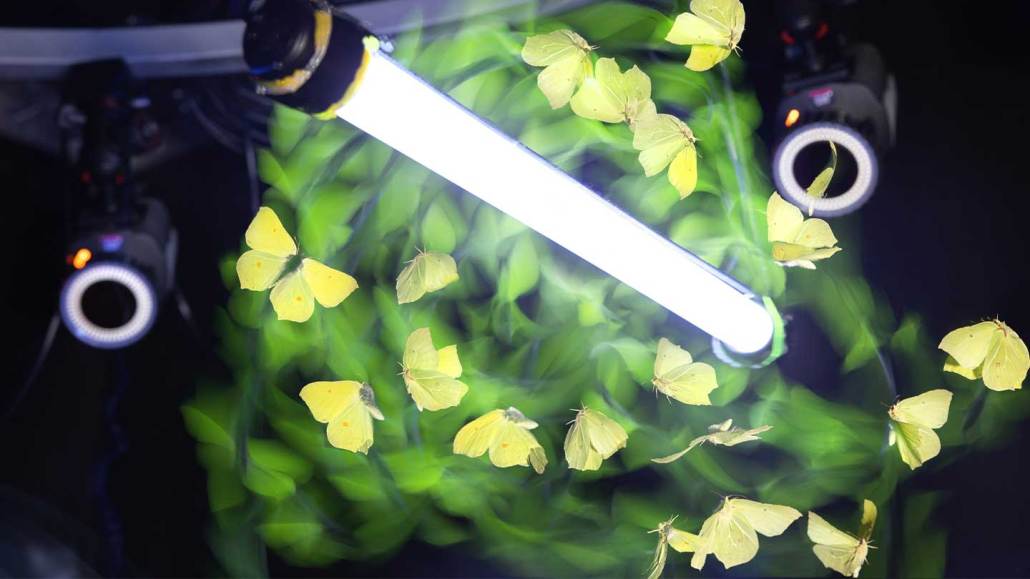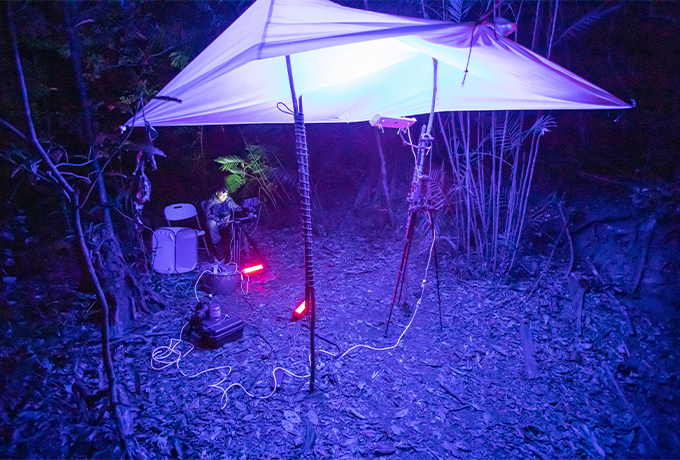Insects flocking to artificial lights may not know which way is up
New high-speed video suggests efforts to keep their backs to the light leads to erratic flight

A brimstone butterfly (Gonepteryx rhamni), shown in multiple locations using motion capture, tries to keep its back toward a tube light as it orbits it inside a laboratory at Imperial College London. This abnormal flight behavior around artificial light may make the insect lose its sense of direction.
Thomas Angus
The insects flying in circles around your porch light aren’t captivated by the light. Instead, they may have lost track of which way is up, high-speed infrared camera data suggest.
Moths and other insects naturally turn their backs toward light. But when insects turn their backs on artificial light sources, their sense of direction seems to go topsy-turvy, researchers report January 30 in Nature Communications. The insects may lose track of where the ground is, leaving them flying in circles or diving toward the ground.
The findings are the first “satisfying answer to a long-standing phenomenon” of how moths and other insects flock to streetlamps and flames, says evolutionary biologist Florian Altermatt of the University of Zurich who was not involved with the study. “It was also interesting to see that it was an actually rather simple explanation, defying the previous, more complex ones.”
Those hypotheses range from flying insects being blinded by light and becoming trapped, to insects interpreting light sources as a place to fly for a quick escape. Another idea suggests that the light of the moon serves as a compass, and nocturnal insects mistakenly use human-made lights to navigate the world. These lights can be deadly for insects (SN: 8/31/21).
Just as pilots flying planes have myriad tools to work out which way is up when they’re gaining speed, flying insects may turn their backs on the sky’s light to keep their feet pointing toward the ground. “It’s a really good idea until somebody invents the LED,” says entomologist Samuel Fabian of Imperial College London, “at which point it’s a very bad idea.”
Fabian and colleagues used high-speed infrared cameras to track how artificial lights affected the flight of a variety of insects. At a field station in Costa Rica, the team watched as wild insects from 10 orders, including moths and flies, circled endlessly around hanging or standing lights. Others flew upward in a steep climb, losing speed until they couldn’t fly any higher. When the light source pointed up, some individuals flipped over and headed for the ground.
During flight, the insects consistently kept lights at their back, even if they ended up crashing. The same was true of moths and dragonflies observed in the lab.
The results “didn’t fit with any of the theories that had been proposed before,” says coauthor Yash Sondhi, an evolutionary biologist at the Florida Museum of Natural History’s McGuire Center for Lepidoptera and Biodiversity. The insects weren’t flying toward the light as they would if it symbolized an escape route. Nor were they flying in smooth spirals, which would suggest the light acted as a compass.
Instead, “it’s a bit like somebody’s grabbed [a pilot’s] joystick and is pulling it in the wrong direction,” Fabian says.
Normal flight was restored when the positioning of a skylike artificial light was opposite the ground. Crash landings were common when the team illuminated a white sheet on the floor. But when a white sheet stretched into a canopy above the floor was bathed in diffuse light, like the sky would be, insects flew through without getting trapped by the light.

In the lab, there were some exceptions. Fruit flies (Drosophila species) — which can fly in the dark — weren’t strongly affected by the light. Oleander hawk moths (Daphnis nerii) could also fly over ultraviolet or LED lights without being thrown off course. In the wild, though, the moths still crash. It’s unclear why, Sondhi says, but one possibility is that the insects might sometimes suppress their response to light. Or it could be something that individuals learn over time.
While it’s clear that artificial light can put insects on a crash course, more research is needed to confirm if it’s happening because insects use the sky’s light for navigation, irrespective of the presence of artificial light, says animal and visual ecologist Brett Seymoure of the University of Texas at El Paso, who wasn’t involved with the research.
Seymoure, Sondhi and other scientists are also teaming up to explore other unanswered questions about light pollution’s effects on insects, such as how susceptible insects may be at different latitudes.
Another question Seymoure and colleagues are exploring is whether putting fixtures on lights, so insects can’t see much light at all, could make streetlights less attractive for flying by insects. “Now that we have the mechanism of how moths are flying to these lights, we can now better design light fixtures that will make it so that they’re not actually doing this behavior,” Seymoure says.






